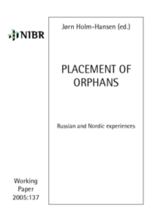The chapters in this Research Note are grouped in three sections. The first section (chapters 2–5) presents the international experiences. The second (chapters 6–7) presents the Russian background, whereas the third section (chapter 8–9) offers an updated presentation of Russian realities as to the placement of orphans.
In chapter 2, Jørn Holm-Hansen addresses the issue of policy transfer distinguishing between “lender-driven” and “borrower-driven” transfer. In chapter 3, Sven Hessle and Yvonne Askerlund argue that institutions that are harmful to children should be closed down. Ten million children throughout the world are living in institutions. Hessle and Askerlund present a procedure for dismantling institutions. The procedure is based on decision-making and process analysis. As a part of the presentation they address the question whether one model possibly could be applicable for such a diversified field worldwide.
Chapter 4 addresses the issue of parent involvement when child care authorities plan and deliver care. Basing herself on the theoretical literature in the field, the author, Mona Sandbæk, argues that stability for children under care is of utmost importance, and that the biological parents is a major source of stability.
In chapter 5 Anne–Dorthe Hestbæk presents the development of out-of-home care in Denmark. The chapter is based on quantitative data that are placed in their contextual framework. The situation in Denmark is marked by the growing number of children and juveniles subject to either preventive measures or placements. In chapter 6 professor Lev V. Mardakhaev addresses the present day situation regarding what in Russia is termed “social orphanhood”, i.e. children whose parents lose parental rights. Professor Mardakhaev points at the ways social problems, attitudinal changes and behaviour are interlinked in the context of Russian transformation.
Chapter 7 is about the history of care for orphans in Russia. Professor Mikhail V. Firsov, gives an overview going as far back as to the Ancient Rus in the tenth century. Professor Firsov point at the variety of placement forms as well as the variety of actors (not only state) in the history of Russia. Among other things he shows how the phenomenon of secrecy in adoption issues, that still characterizes Russia, was subject to an imperial decree as early as 1715.
Mikhail V. Firsov, Lars Kristofersen, Larisa S. Malik, Lev V. Mardakhaev, Trine Myrvold, and Jørn Holm–Hansen (chapter 8) depict and analyse the preconditions and obstacles for successful policies of supporting alternatives to orphanages in the NorthWestern town of Arkhangelsk. The chapter looks into the role of the various actors taking part in the policy field of taking care of orphans. Two possible “advocacy coalitions” are suggested, the “residential care coalitions” and the “coalition for family-like alternatives”.
Chapter 9 offers an insight into the relatively fresh discipline of social work at one of Russia’s universities, the Pomor State University of Arkhangelsk. By way of presenting recent diploma works on placement of orphans, the author Larisa S. Malik, shows how child care is being strengthened and developed in Russia.

